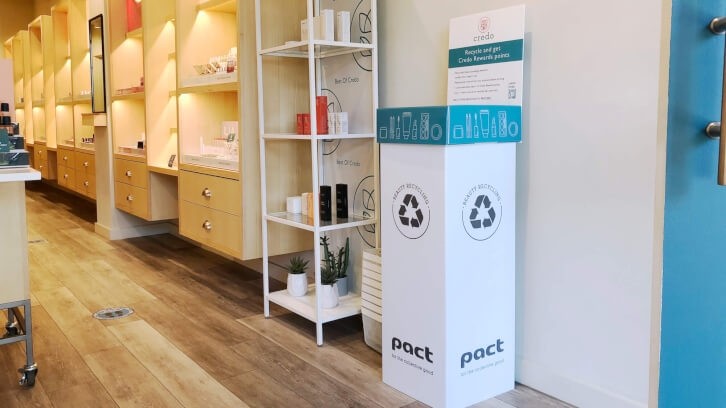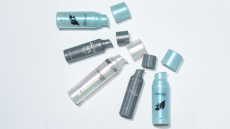Sustainable packaging non-profit expands into Sephora North America stores

Earlier this year, CosmeticsDesign attended the Makeup Show NYC and participated in a seminar led by Victor Casale, CEO/Co-founder of makeup brand MOB Beauty. In the seminar, Casale shared some information about MOB Beauty’s role in co-founding the Pact Collective, a non-profit organization dedicated to making beauty and wellness packaging more sustainable.
To learn more about the Pact Collective, including the organization’s mission, potential industry impact, how the organization works to improve packaging sustainability, and how industry members can get involved with the organization, CosmeticsDesign interviewed Carly Snider, Pact Program Director for her insights.
CDU: Can you share some background information about the Pact Collective’s mission, how it was founded, and how it currently operates?
Carly Snider (CS): Pact is a nonprofit collective working to make beauty and wellness packaging more sustainable. We aim to do this by uniting the industry to solve our packaging problem, together.
Pact was founded by cosmetic brand MOB Beauty and Clean Beauty Retailer Credo to take responsibility for our packaging's impact. Circularity requires us to work together, share knowledge, and push each other towards a more sustainable future.
Credo and MOB recognized this and set out to catalyze it for the industry. Today, Pact has more than 175 members across beauty and wellness who are committed to this pre-competitive collective approach.
CDU: Could you provide some background information about how the Pact Collective program works regarding the actual submission, collection and recycling process?
CS: All of the material collected through Pact’s collection programs are processed and sorted by material type/end-of-life likelihood. From there, Pact aims to find the highest and best use for the material collected.
Pact’s highest and best use hierarchy is as follows: upcycling into another product (e.g. packaging, carpet, pallets for warehouses); downcycling into a lower value item (e.g. asphalt); molecular recycling (e.g reduced to chemical monomers that can then be used to build something else), and waste-to-energy (packaging that cannot be used in any other way is burned. Pact doesn’t consider this recycling but at least it isn’t in the landfill or environment).
CDU: Can you provide some background information about the application process to become part of the collective, including any criteria or qualifications you’re particularly interested in from potential applicants?
CS: Pact Membership is open to any size company if they are a stakeholder within the beauty and wellness industry. We welcome novices to sustainability experts. As part of membership, Pact members adhere to the Pact Accord and Rules of Engagement.
The Pact accord is as follows:
No one company alone can shift the beauty industry’s packaging supply chain. To drastically reduce our environmental impact, peers and competitors must come together as a collective, adhering to Pact’s values.
Through Pact membership, suppliers, designers, media, brands, and retailers commit to transparency, sharing best practices, speaking a common language, and making meaningful improvements in beauty packaging. We will do this through our beauty-specific collection programs, guidelines and tools, and through member workgroups and events.
By joining Pact, you agree to work together in a collective spirit toward the goal of reducing packaging material use, and increasing recyclability and circularity for our industry, for the greater good of the planet.
Rules of engagement include a commitment to taking action toward circularity as well as showing progress in the sustainability journey. Pact is not here to be a greenwashing exercise for companies, so if members are not adhering to the Accord and Rules of Engagement, they may be asked to leave the collective.
CDU: Are there any challenges that have had to be overcome in order to launch the PACT Collective? If so, what are those challenges and what solutions were developed and implemented to overcome them?
CS: Recycling hard-to-recycle material is challenging due to the size, material type and composition of beauty packaging. We are working with some of the most innovative partners in the space and we are still finding that some of the material we collect must go to waste-to-energy (e.g., incineration, which we do not consider recycling).
We believe the industry needs to know the good, bad, and ugly of our industry to understand our baseline in hopes to make better packaging decisions moving forward.
Another challenge is inspiring the industry to adopt a pre-competitive approach. No one brand can solve our packaging problem alone. Industry-wide collaboration is essential to our ability to meet the urgency of our climate crisis.
CDU: What is the potential impact of the Pact Collective on manufacturers and suppliers to the cosmetics and personal beauty care product industries?
CS: We are proud to currently have several manufacturers and packaging suppliers as Pact members. They are the ones who can drive innovation in better packaging design from the start and we want to be their partner in bringing these positive changes to life.
Designing more sustainable packaging from the start will mean less hard-to-recycle beauty packaging in the future, which means less waste ending up in landfill and in the environment. We believe that packaging suppliers will play a huge role in this.
CDU: What has the industry response been to the Pact Collective program so far?
CS: Extremely positive! We are only two years old, and we currently have 175+ members across the beauty and wellness industries. Pact is a community working toward the same goal of reducing our waste as an industry, and our members have been integral in that.
CDU: Are there any plans to expand the PACT Collective program, and if so, what are those plans?
CS: Continuing to unite the industry to design more sustainably and encouraging its customers to help us close the loop on our hard-to-recycle beauty packaging. We plan to target major retailers to expand our collection bin footprint across the US and Canada for the rest of the year. Piloting with Ulta Beauty in March and launching in all Sephora North American doors in May has already put us on the right track.
Additionally, we want to put pressure on beauty stakeholders to think about how they are processing their unsellable products or obsolete inventory. We hear a lot about the consumer’s role in recycling, but a large volume of our industry’s packaging waste is from our companies’ product returns, expired goods, discontinued SKUs, etc.
Product destruction of these types of packaging is typically an unsustainable process (product is usually burned as a best-case scenario and landfilled as a worst-case scenario). We work to improve this process by taking an extra step to sort out components that can be mechanically recycled (e.g., caps, compacts, cardboard boxes).
Once processed, we will issue a certification of destruction to the company whose inventory we processed. This has the potential to drastically reduce the packaging from ending up in landfills.
CDU: Anything else to add?
CS: If you are interested in joining Pact, you can learn more here or fill out our membership application.













